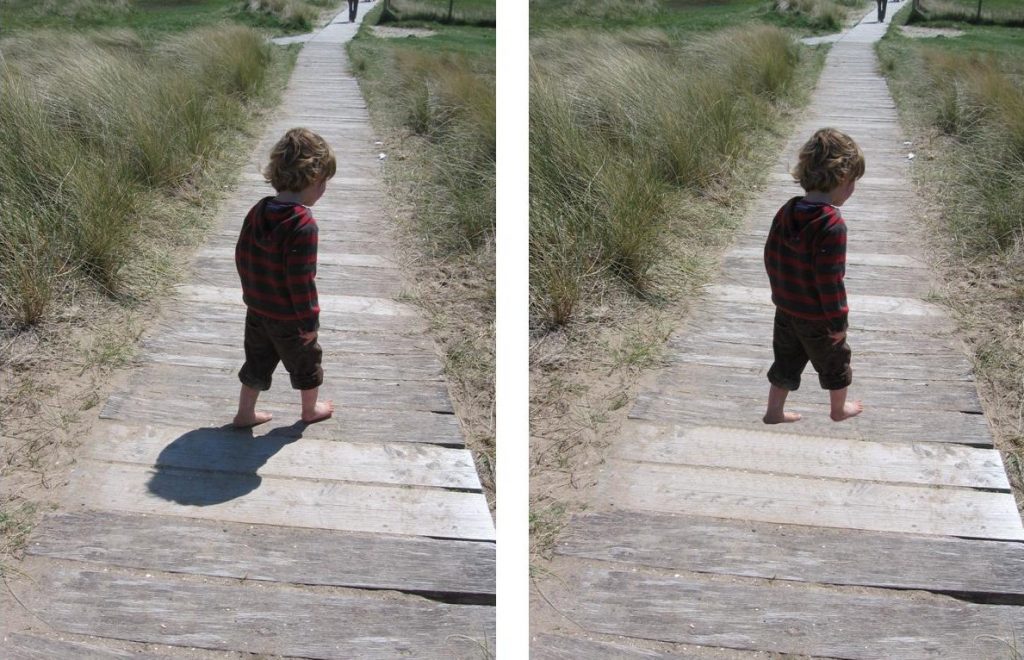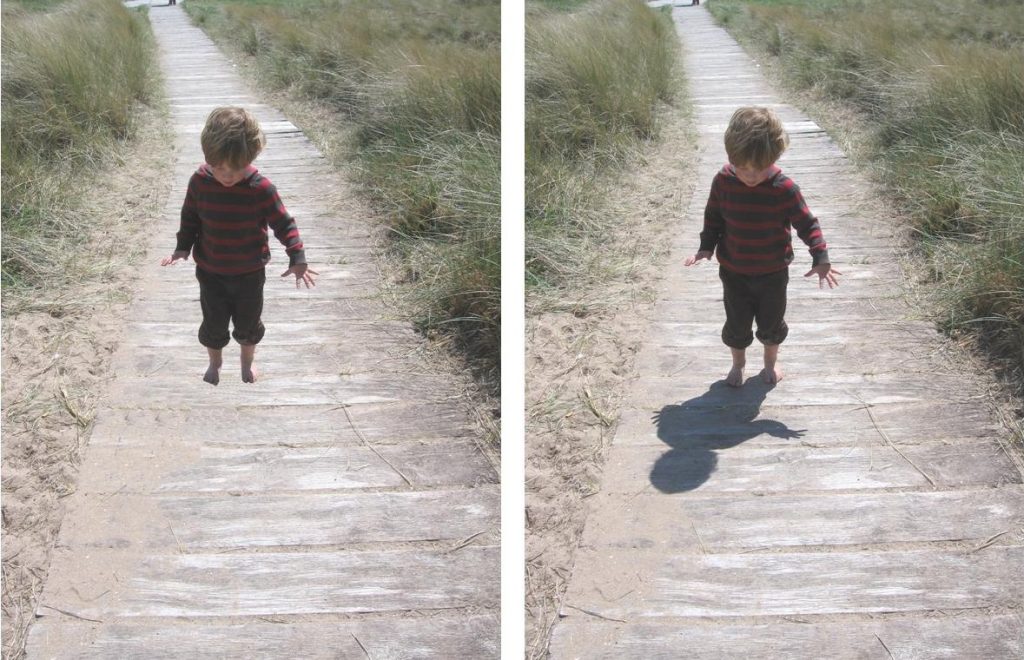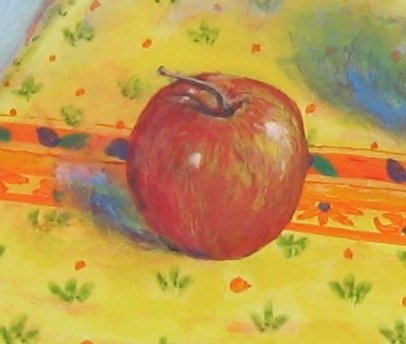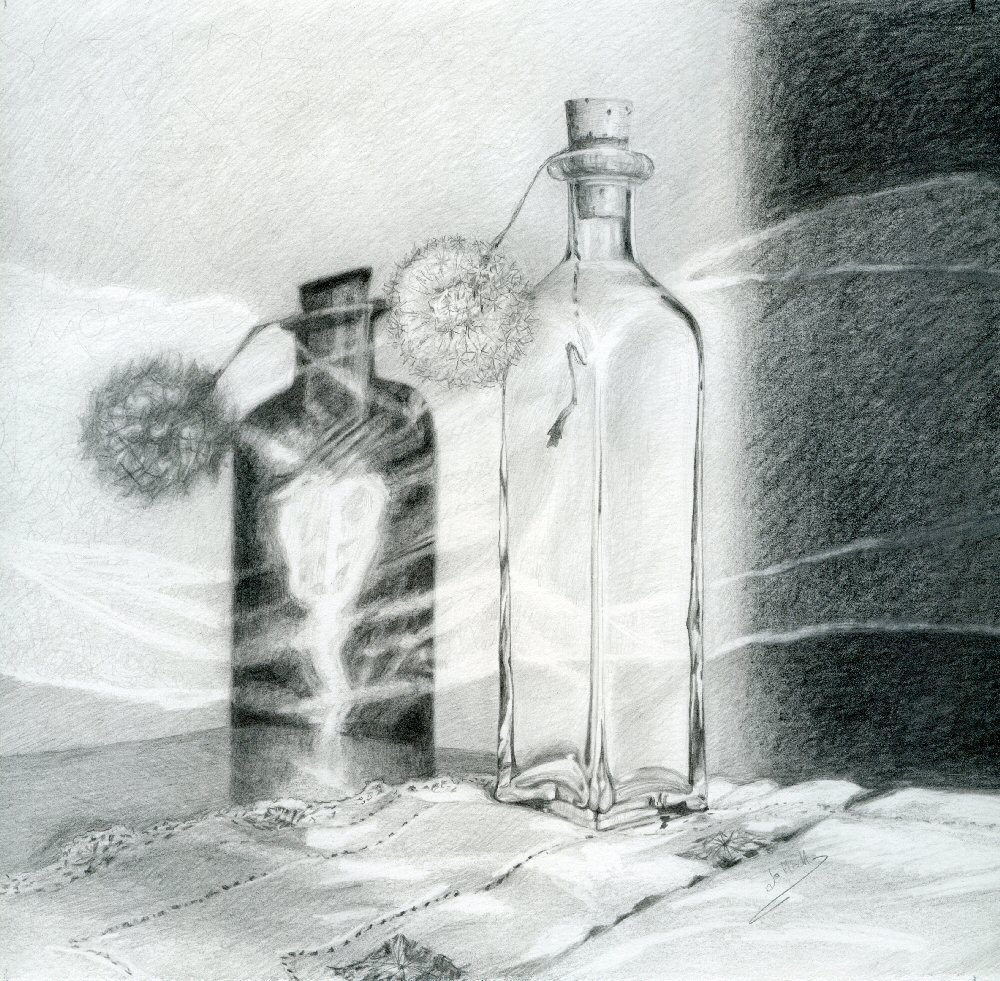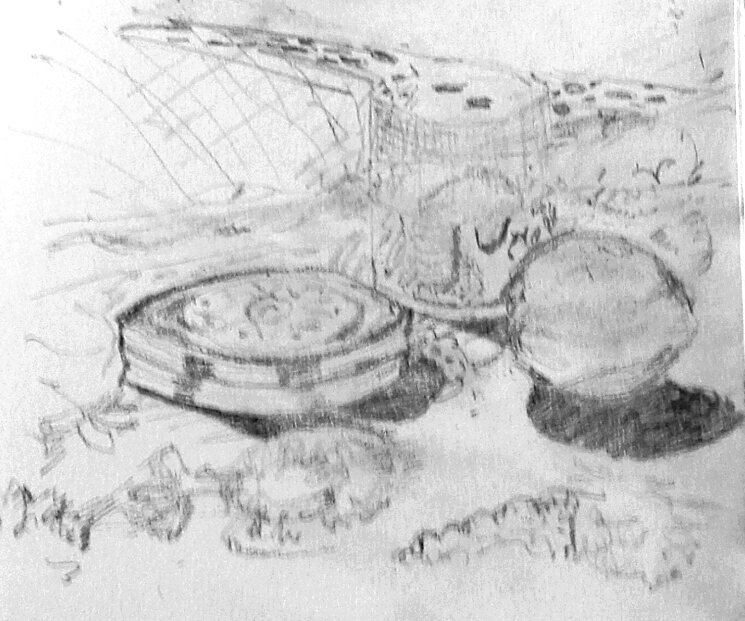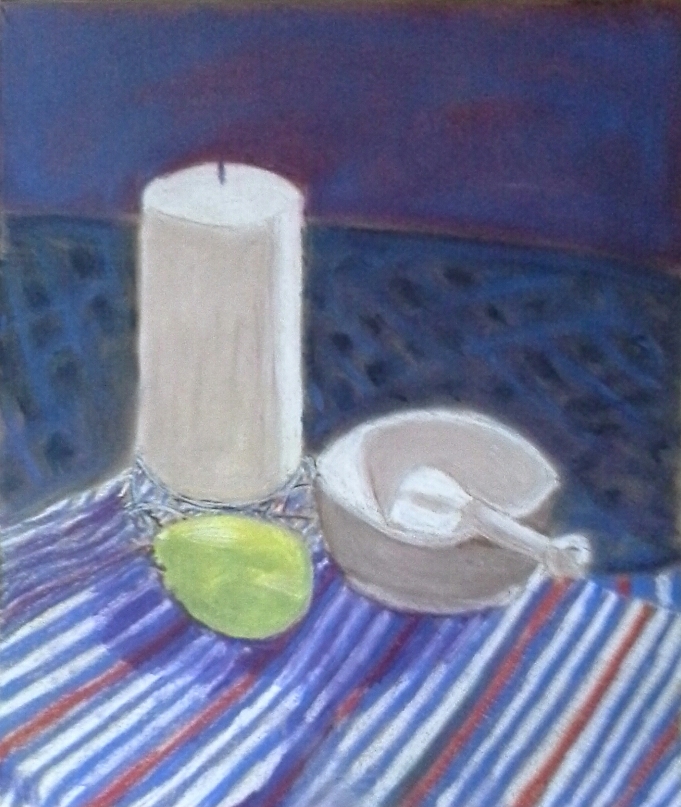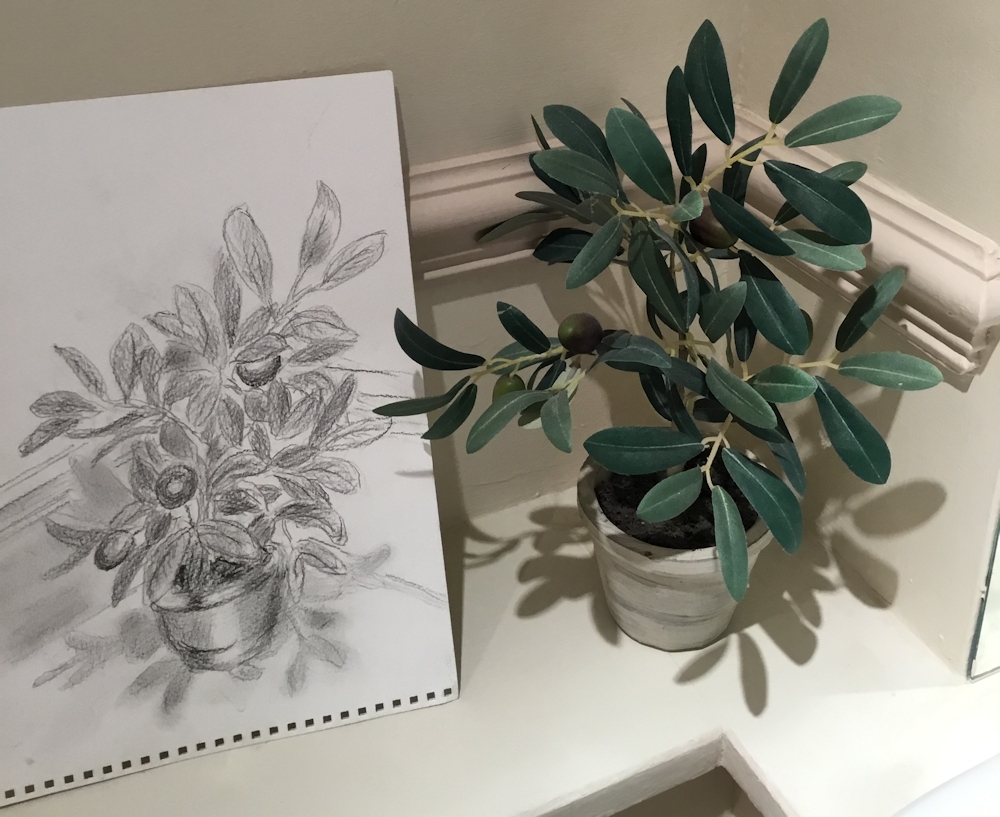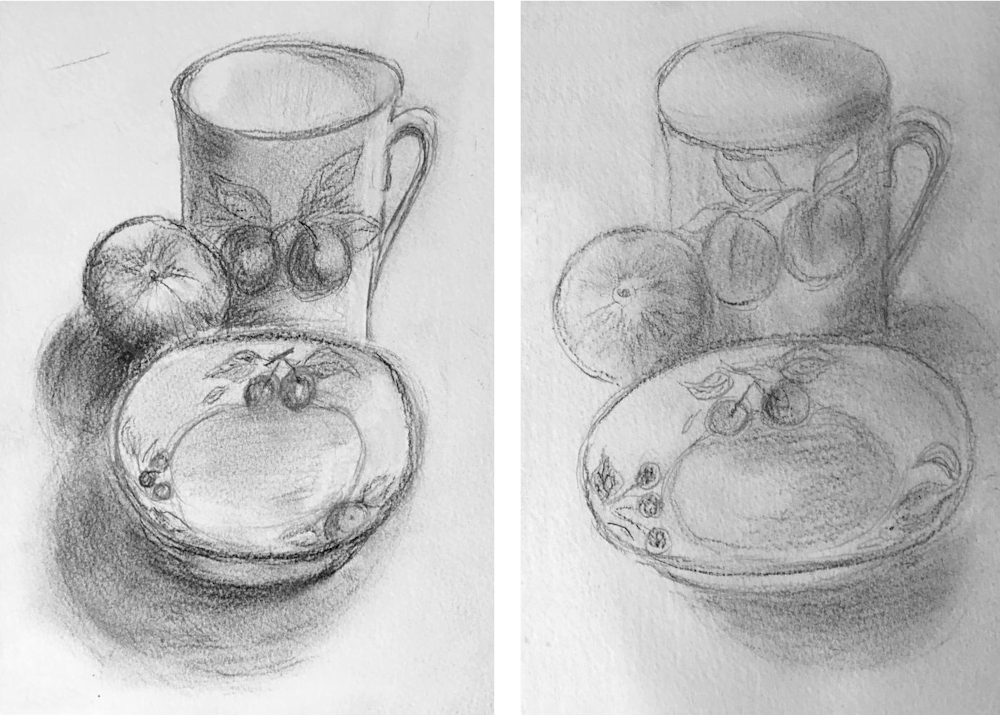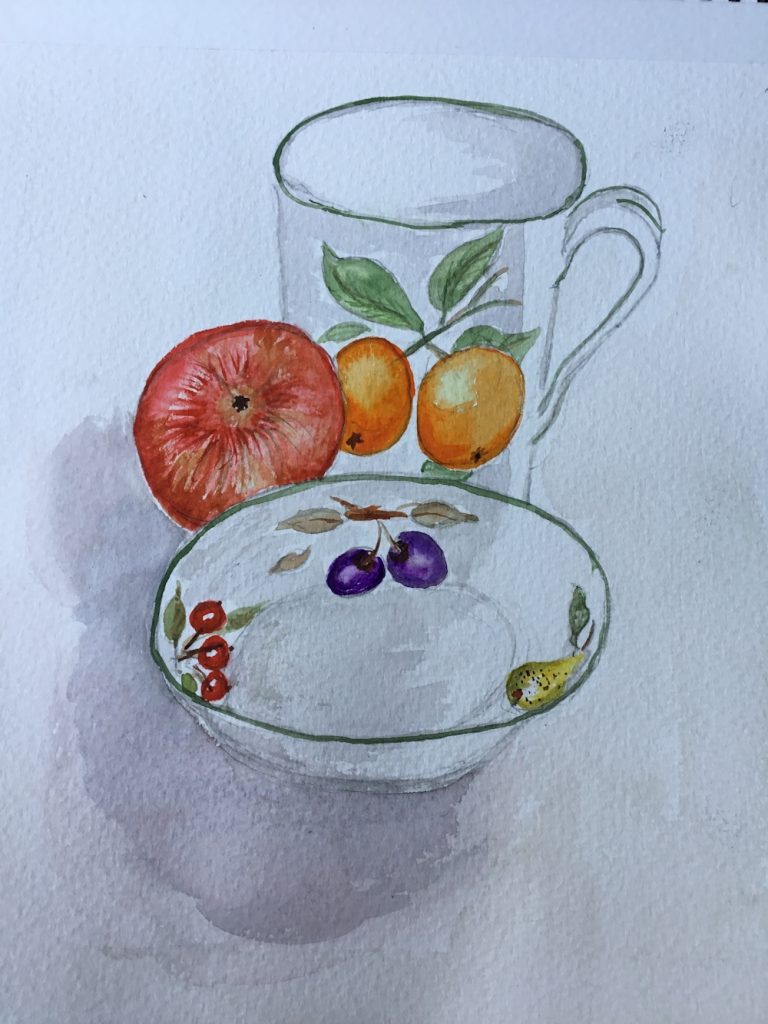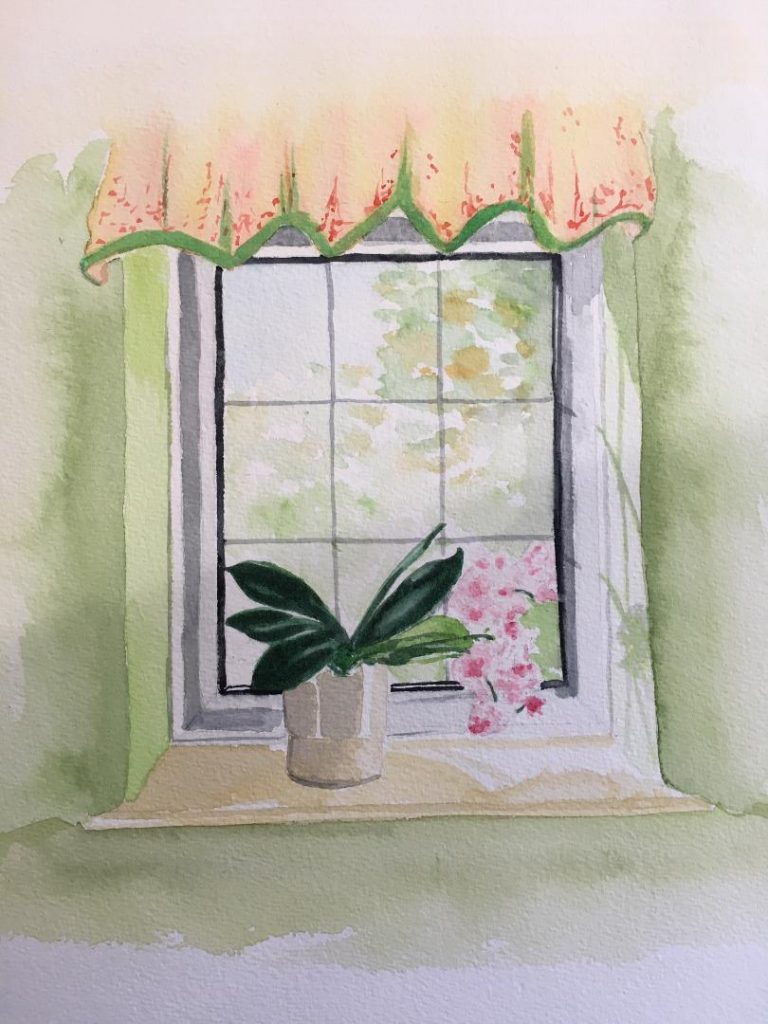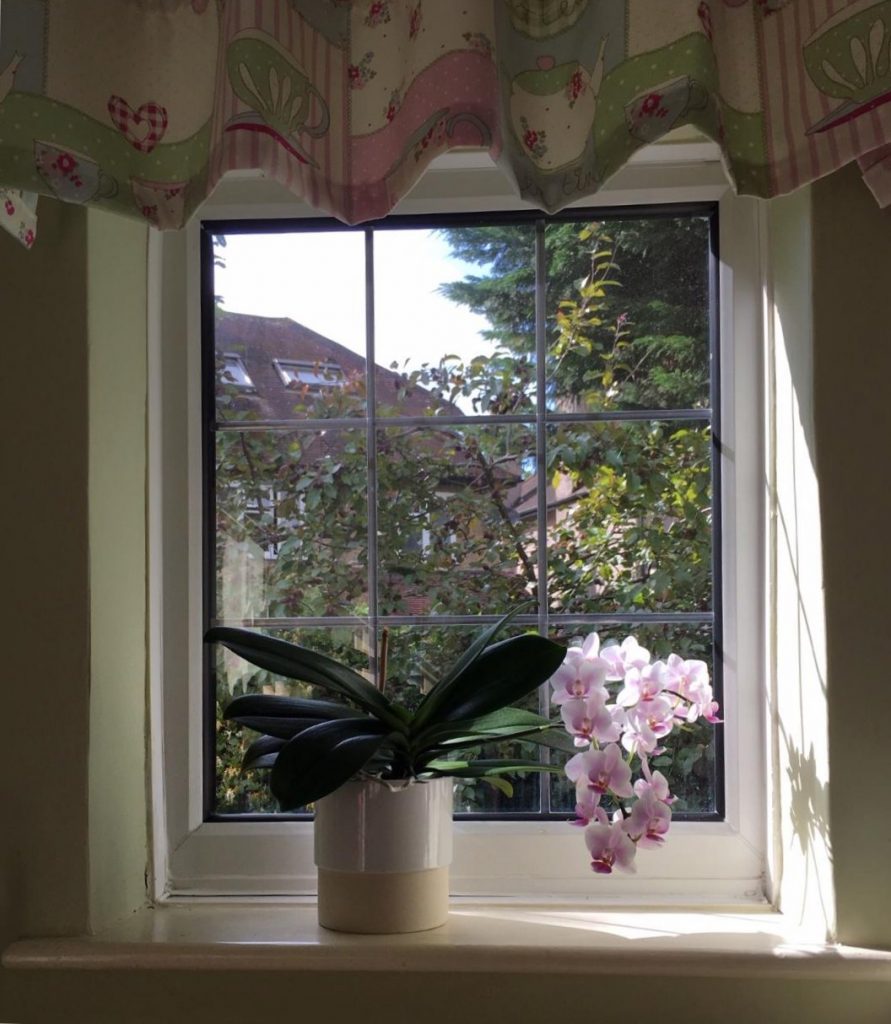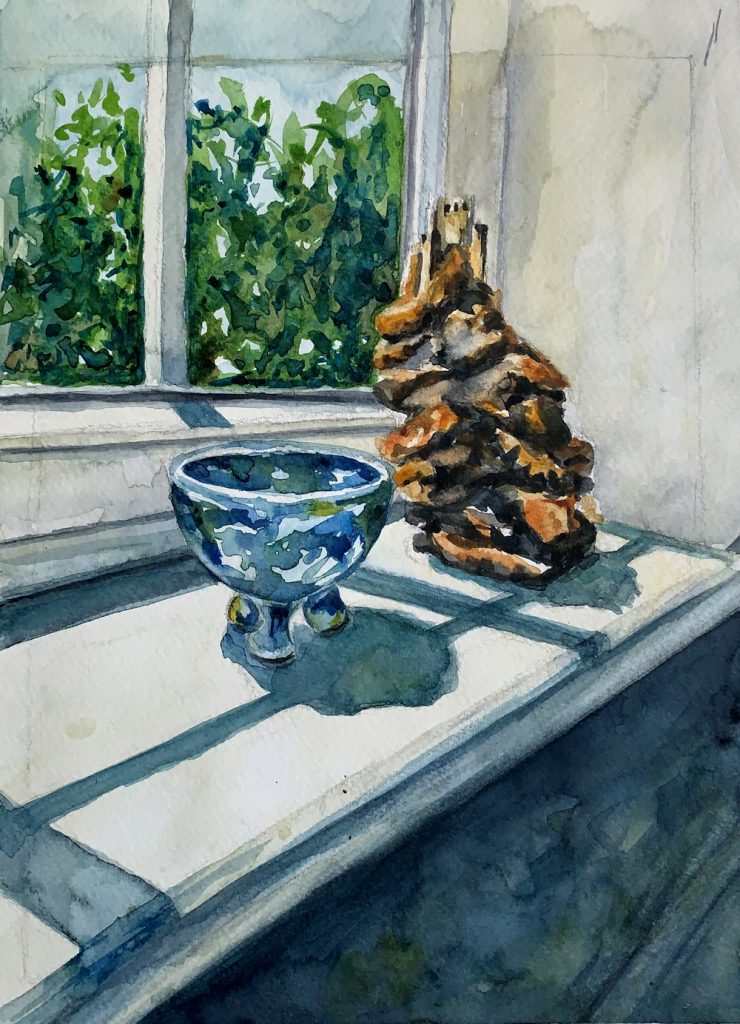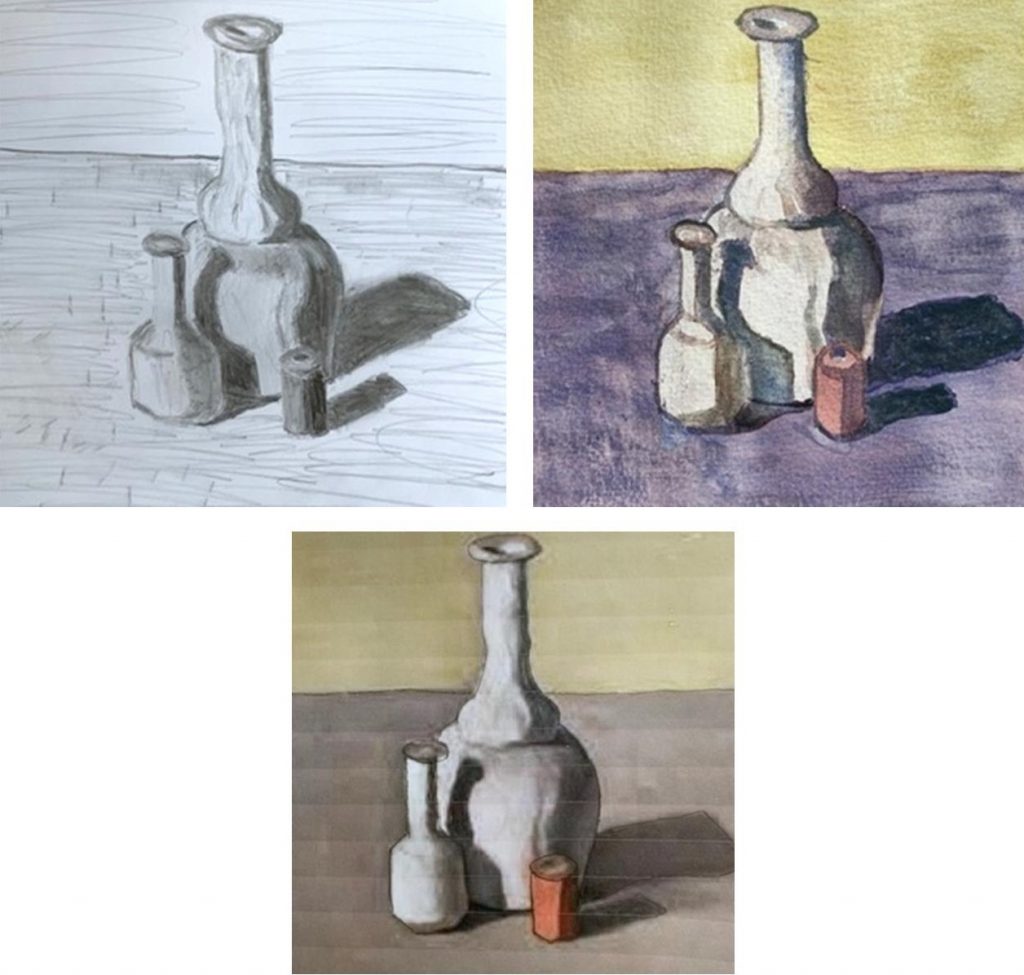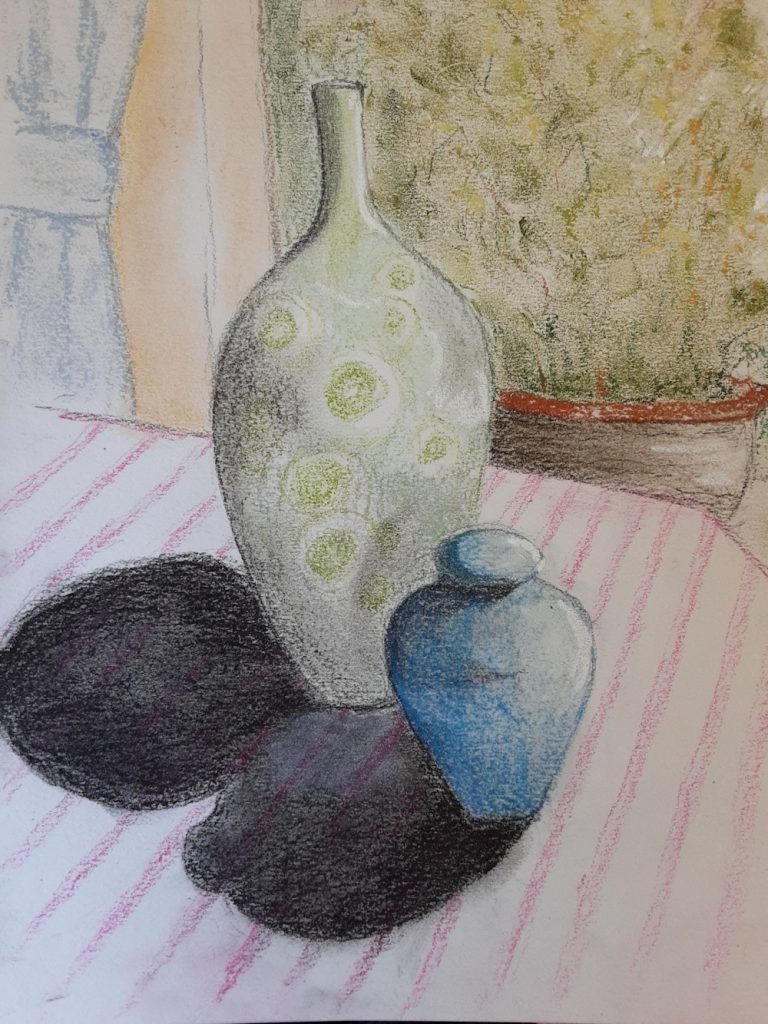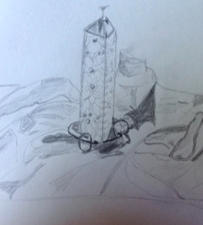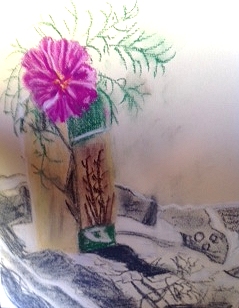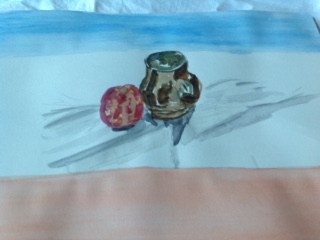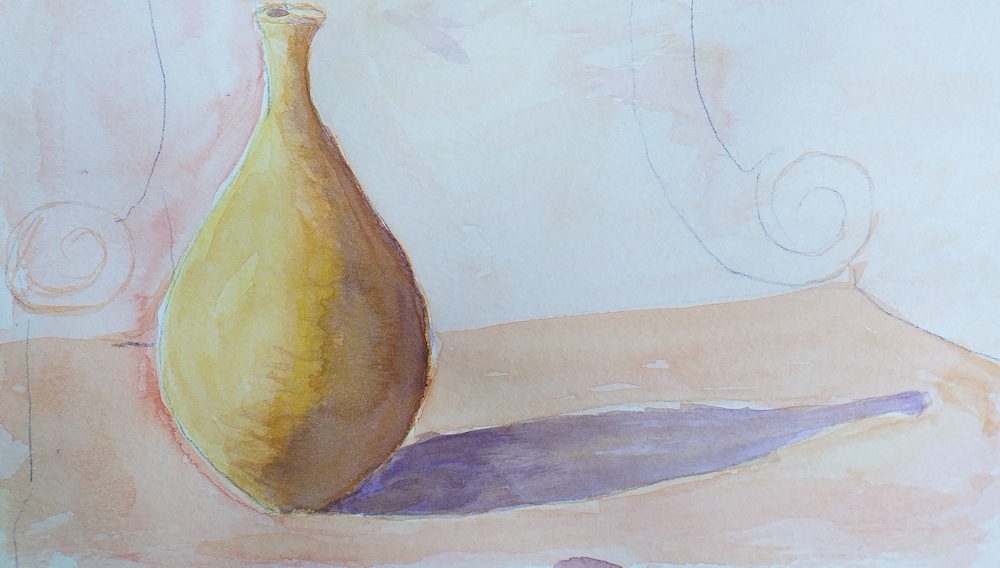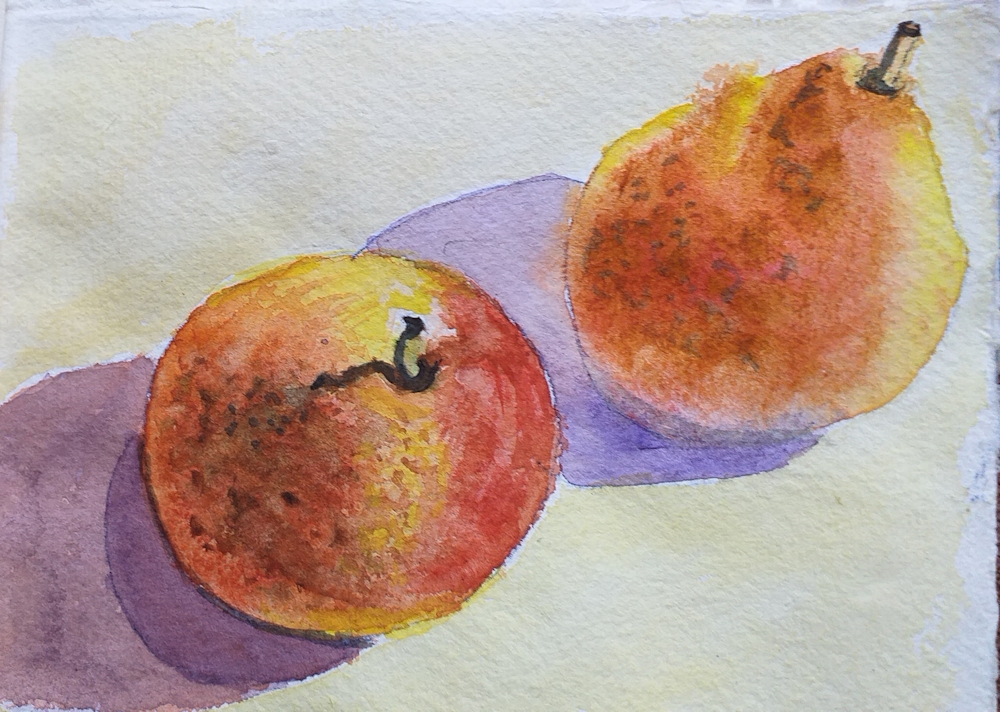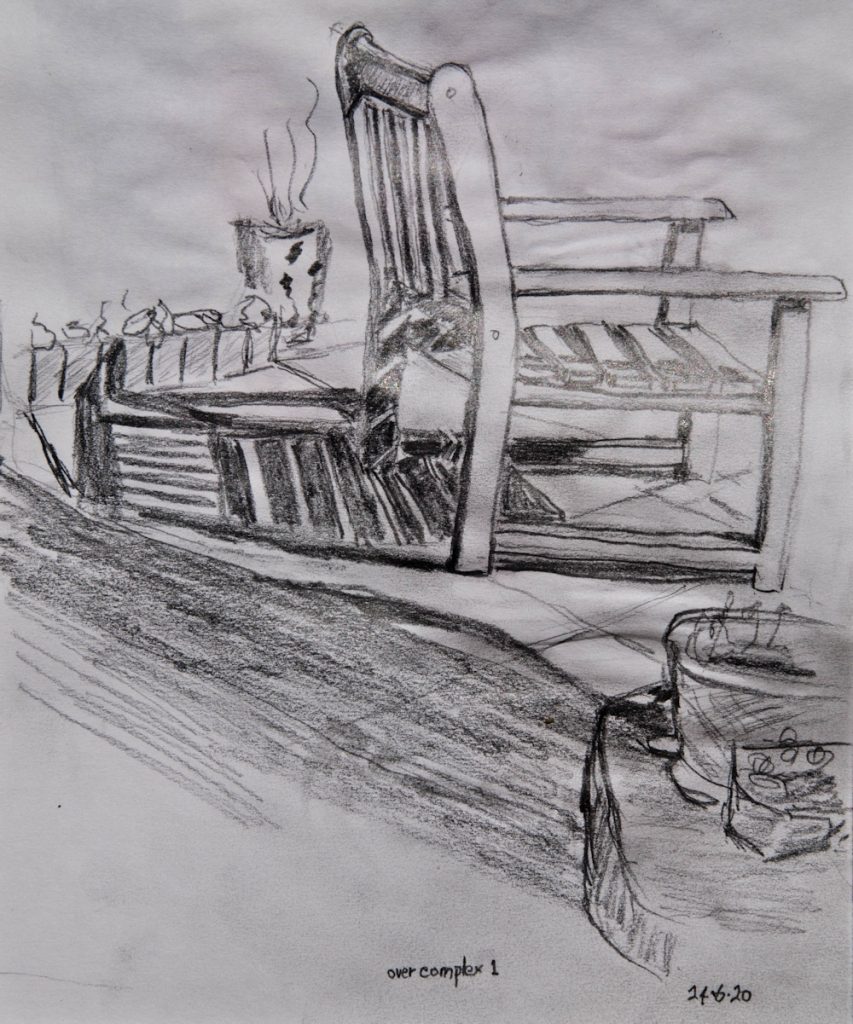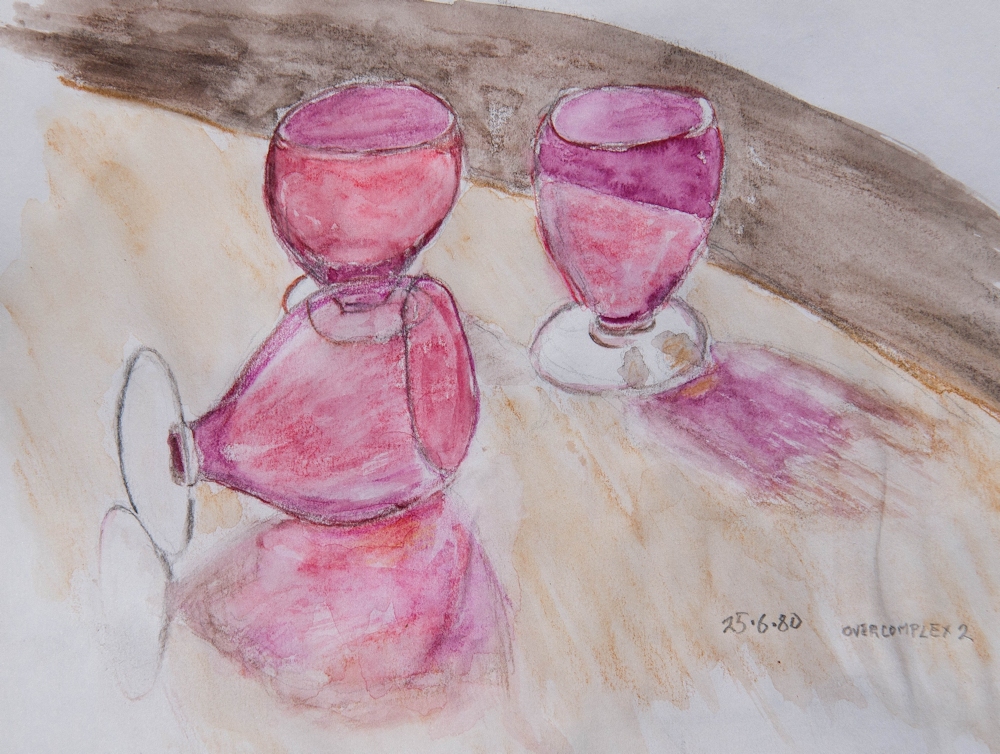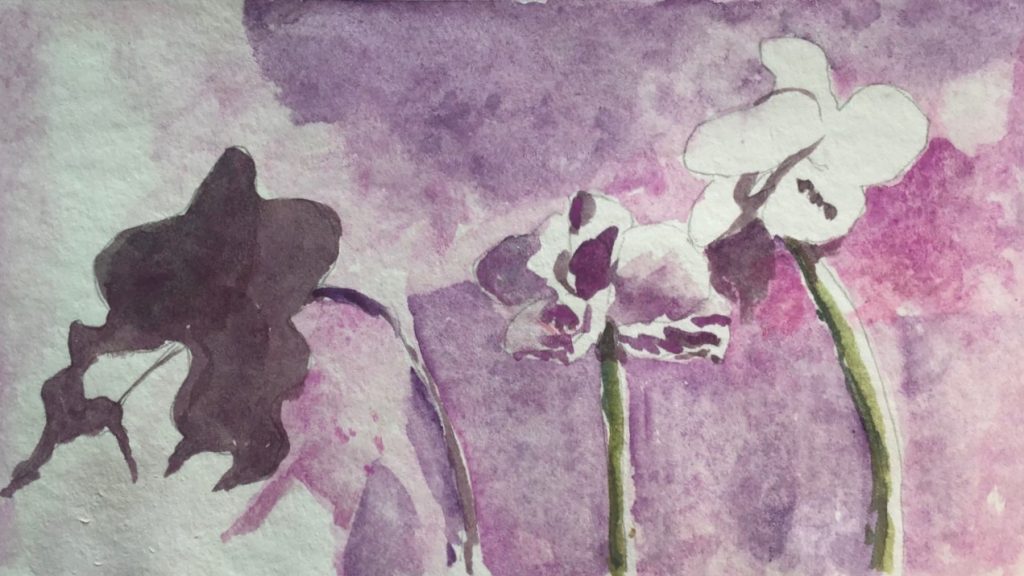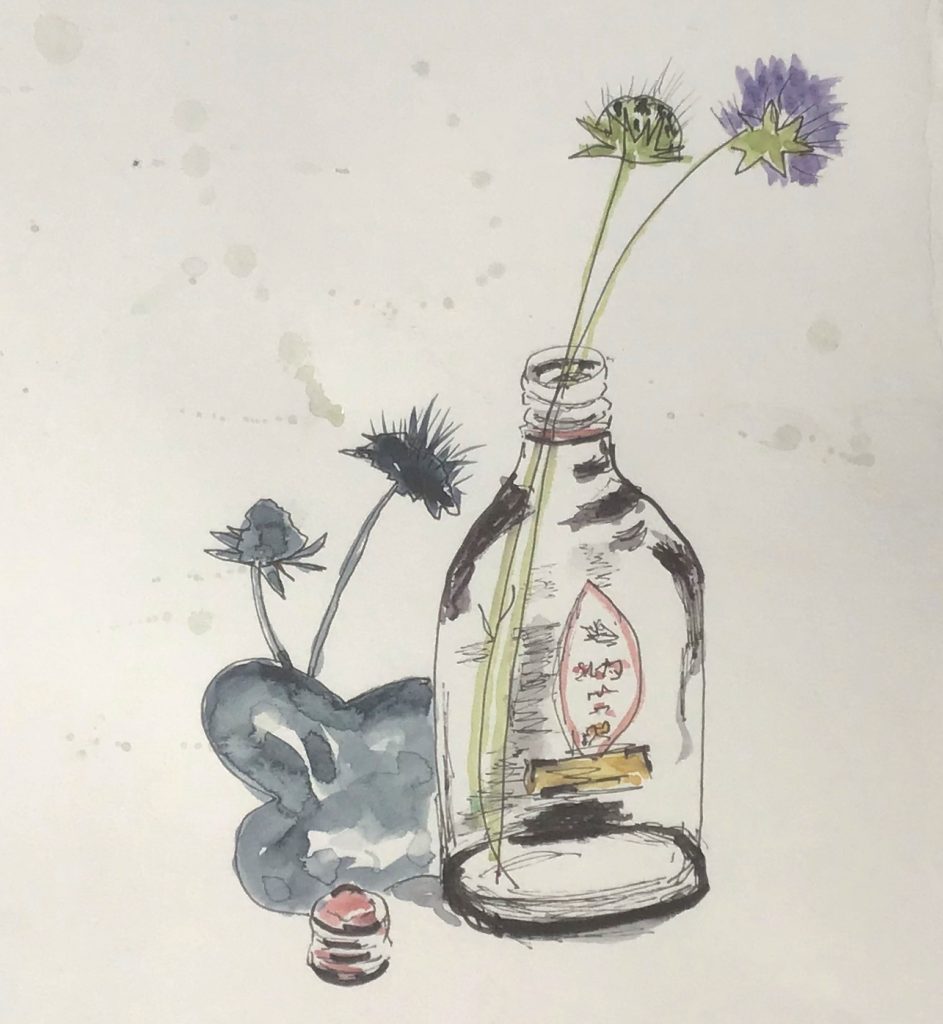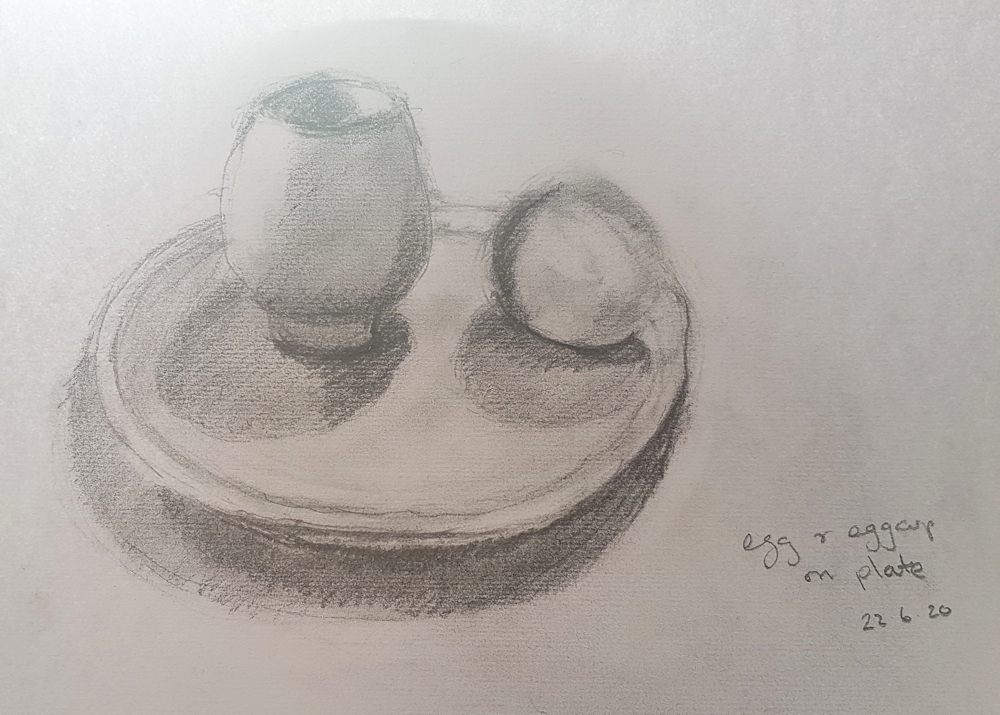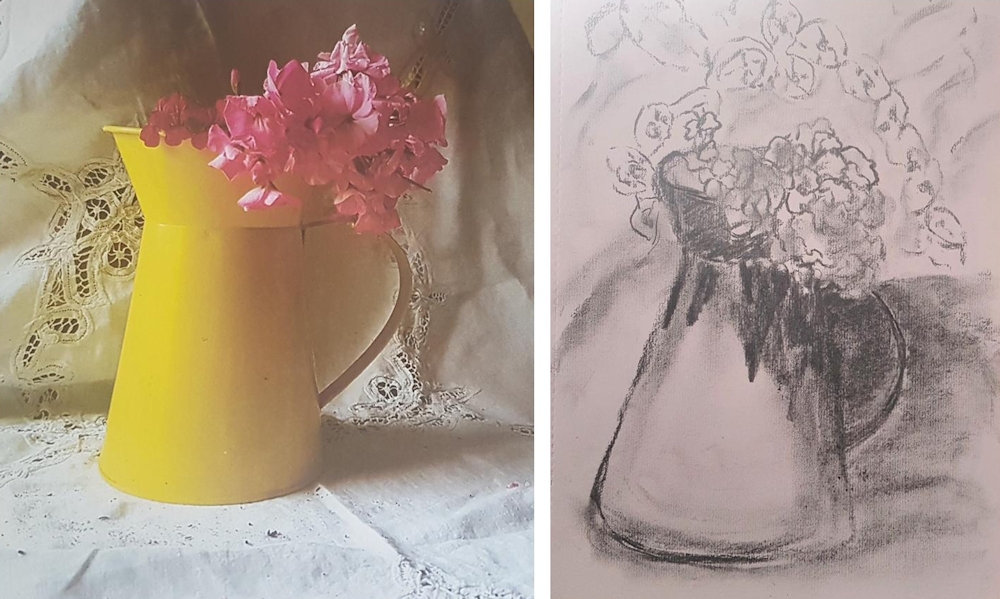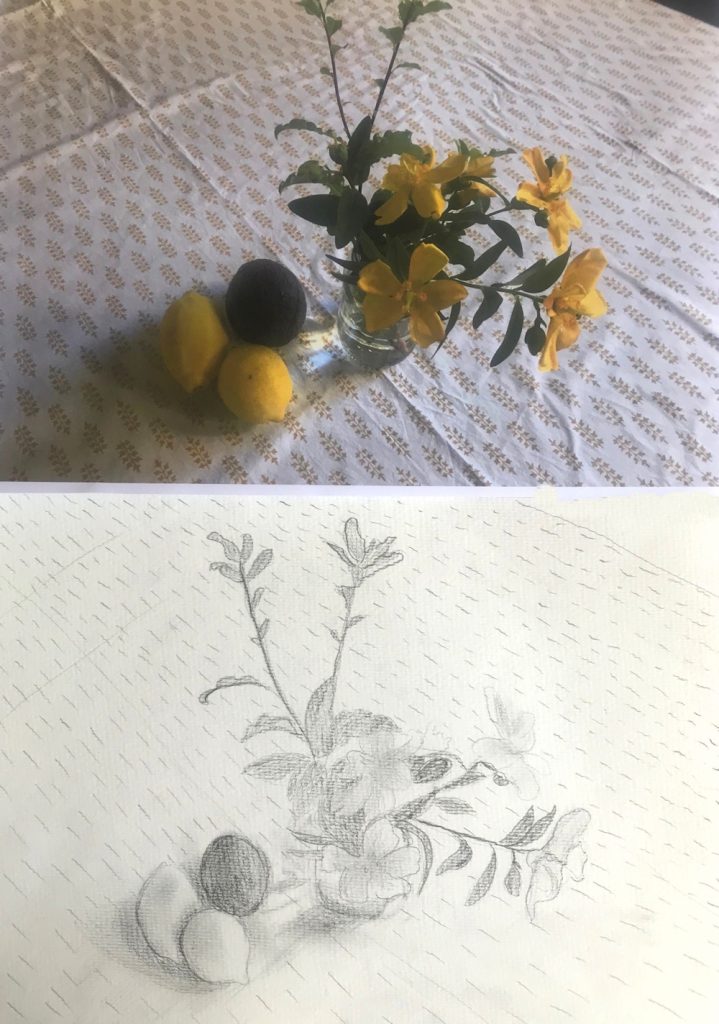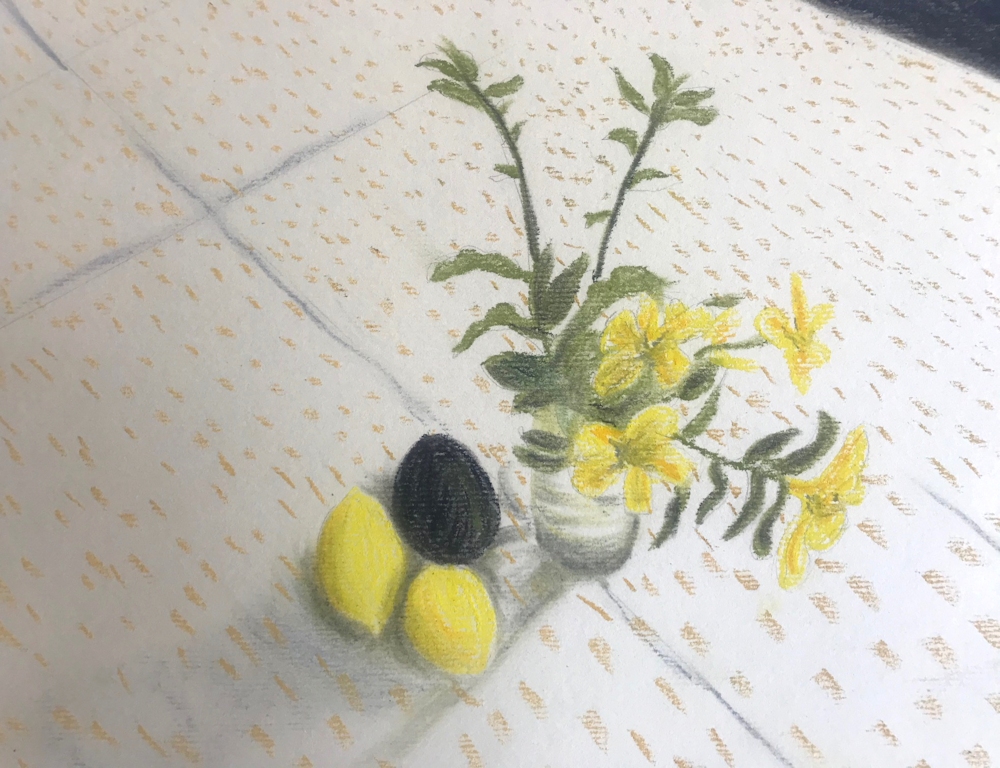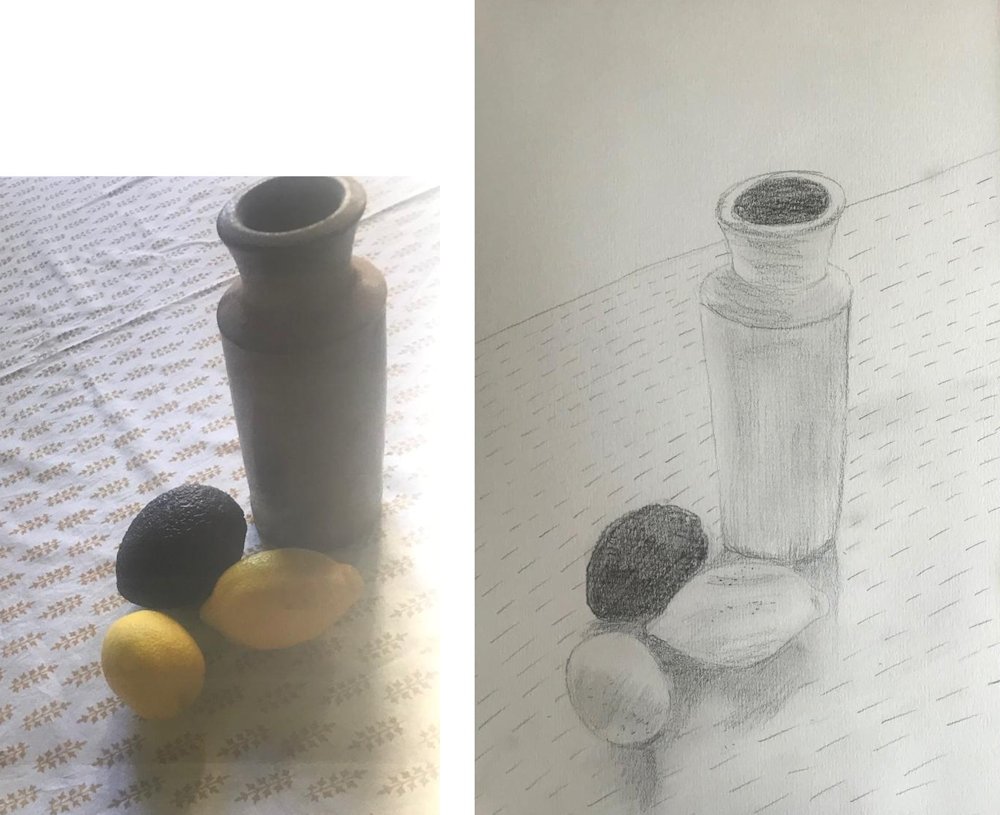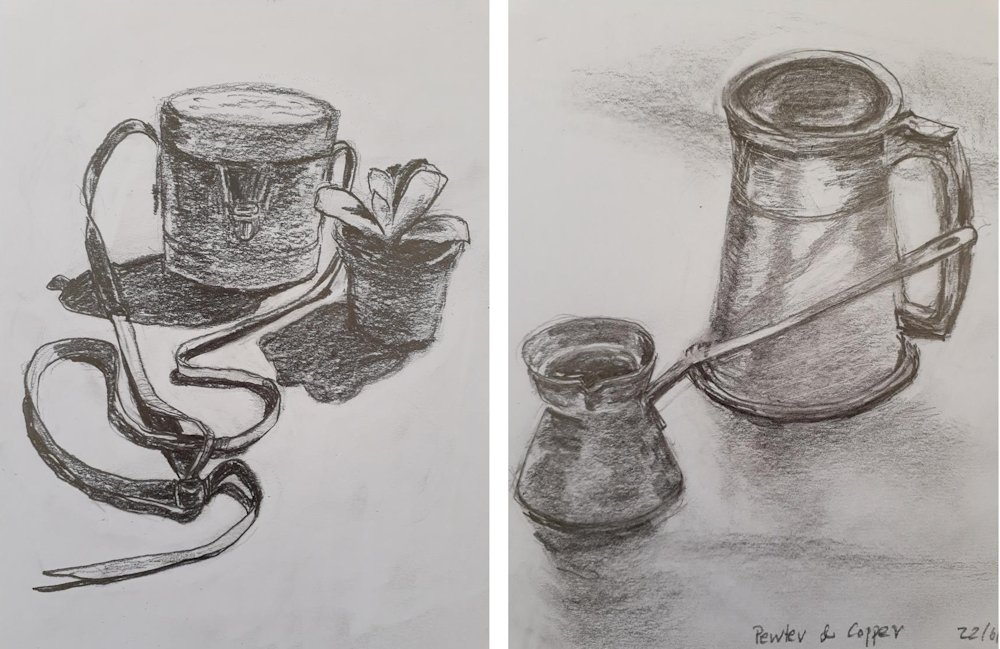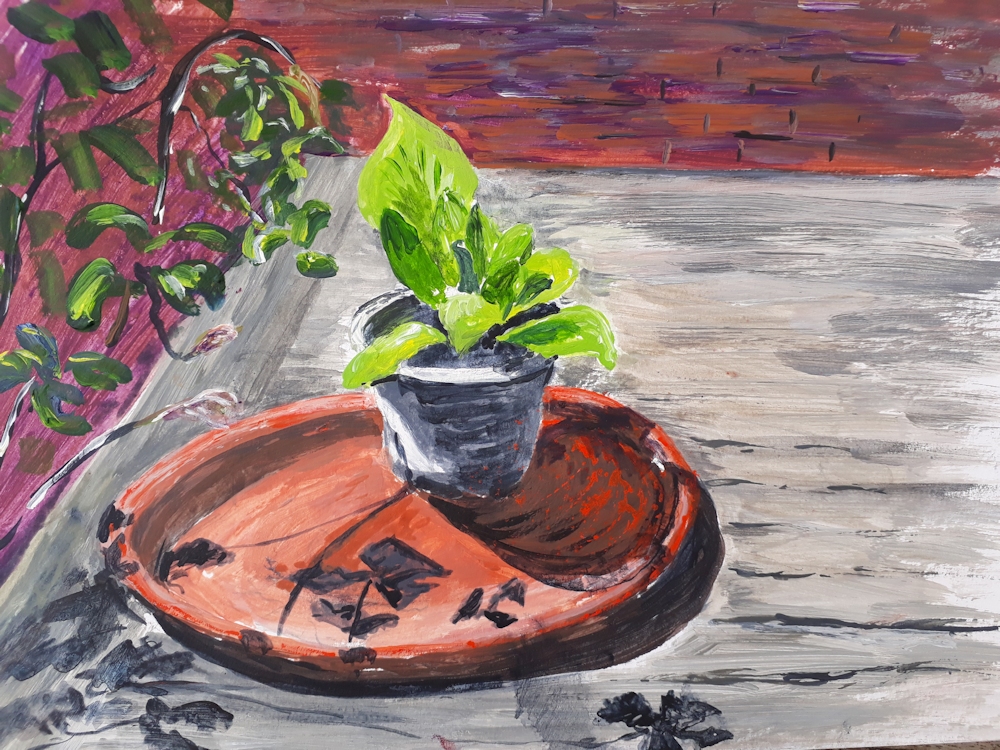Cast Shadows 1 Still Life
June 19, 2020
Cast Shadows introduction and Still Life
I love those Peter Pan moments when you tell a child that he’s lost his shadow and he looks in the wrong direction so you tell him to turn round and!
Fortunately Toby’s shadow returned a few seconds later or he might have been flying off to find pirates in Never Never Land instead of going on a bear hunt in the dunes.
Introduction
What exactly is a cast shadow? I understand it as the shadow made by parts of an object that obstruct the incoming light from appearing on surfaces other than the object itself. This is obvious with the Peter Pan photo, not quite so obvious when it is the cast shadow under a nose (rather than the underside of the nose), more obvious when it is the shadow of a wide brimmed hat that falls over the upper parts of the face. Cast shadows are not for instance the part of the head or hill that is away from the light direction. A different surface has to be involved.
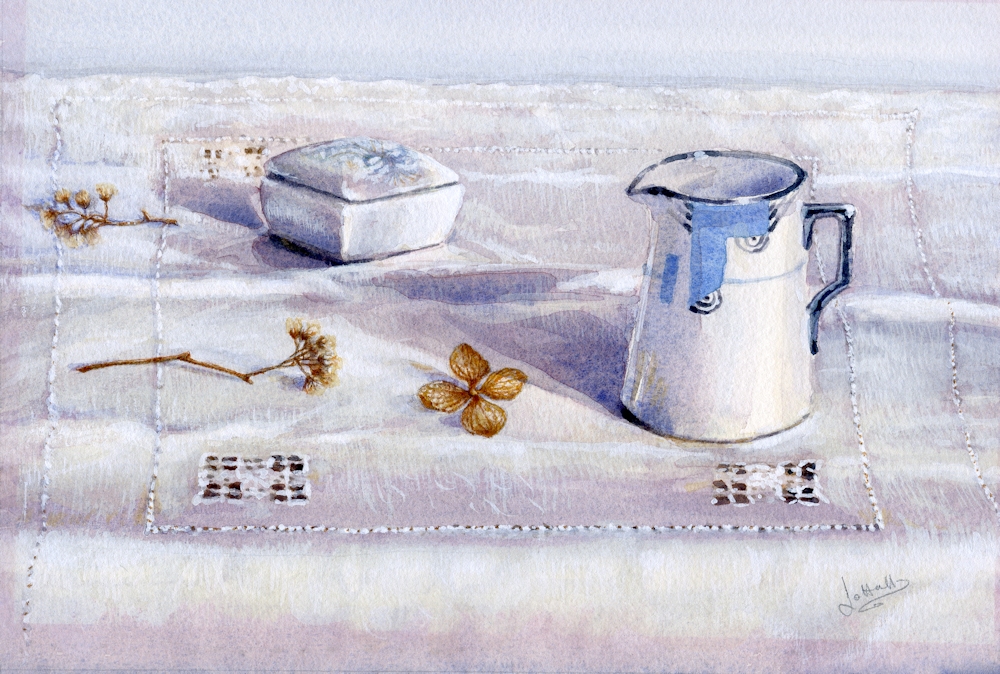
Blue and White Jug: watercolour by Jo, The diagonal shadow cast on the cloth is a similar colour but deeper tone to the cloth and is a strong composition element.
Mostly cast shadows assist in making a composition convincing without being the dominant feature and in the four projects over the next few weeks we will explore this aspect and also how cast shadows may be vital, to the extent of becoming the major element. Visually as seen in the images above cast shadows help to anchor the objects to whatever they are placed on. Mary Fedden R A produced still life paintings including objects with and without their cast shadows, sometimes within the same work and those without really do seem to float in the composition.
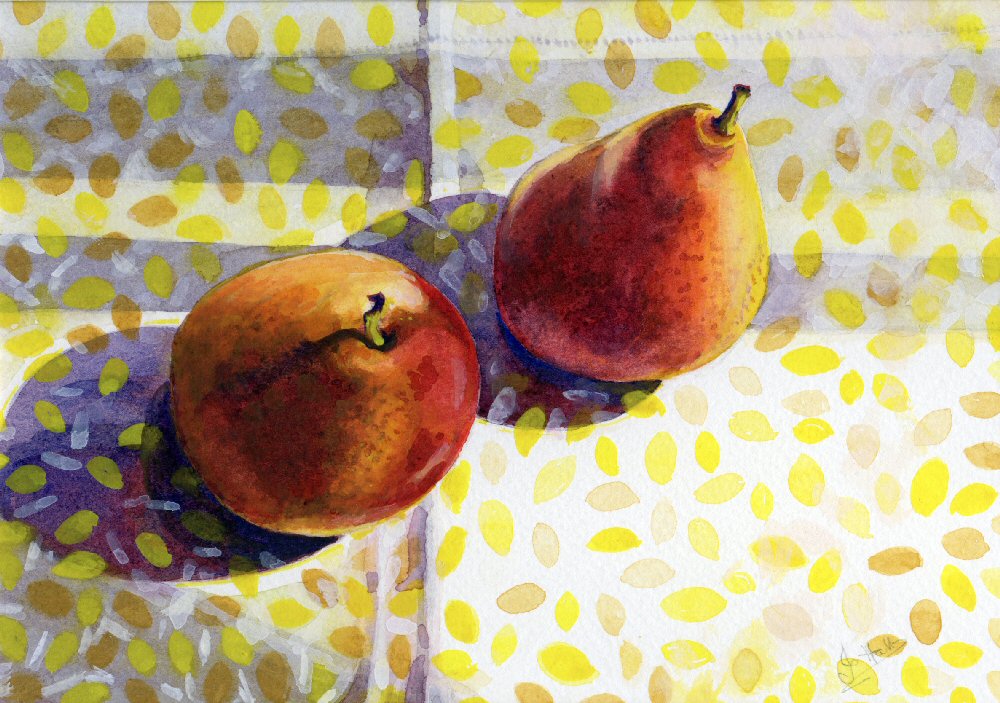
Pears on Yellow Patterned Cloth: watercolour by Jo, strong sunlight, sharp shadows, rather purple cast shadows of pears
Cast Shadows and Still life
We can easily think of shadows as just being darker areas of tone but they also have colour and artists have exploited this and sometimes even invent shadow colours of pure but believable fiction. Thinking firstly of the tones and shapes of shadows it is most important to establish the light direction in relation to the objects. And still life is a good place to begin.
Imagine a football on a table. Lit strongly, directly from above its underside will appear dark and it will cast a circular shadow on to the table. The size of the shadow will depend on how far the light source is from the table. On a bright day outside, the midday sun will result in a cast shadow on the table approximately the same size as the diameter of the ball. If the football is on a table indoors and lit by a single lamp much nearer the ball, the circle of shadow may be much larger. Both the direction and angle at which light hits the object blocking the light determine the placement of the cast shadow and is why cast evening shadows are much longer than at midday.
This is relatively easy when the object is on a flat table and that is the only plane on which the shadow is projected. If you have a vase of flowers or a pot plant, place it on a table to the side of a window on a sunny day so that a shadow is projected diagonally across the table and on to the wall behind. Observe what happens if you move the vase or pot nearer the wall. If you have an overhead light try putting the arrangement of flowers or plant directly below the light at night. Putting a white or pale cloth under the vase will give a really dramatic effect.
In dull daylight or diffuse light in doors, cast shadows largely disappear and all that be seen may be a rather general difference in tone.
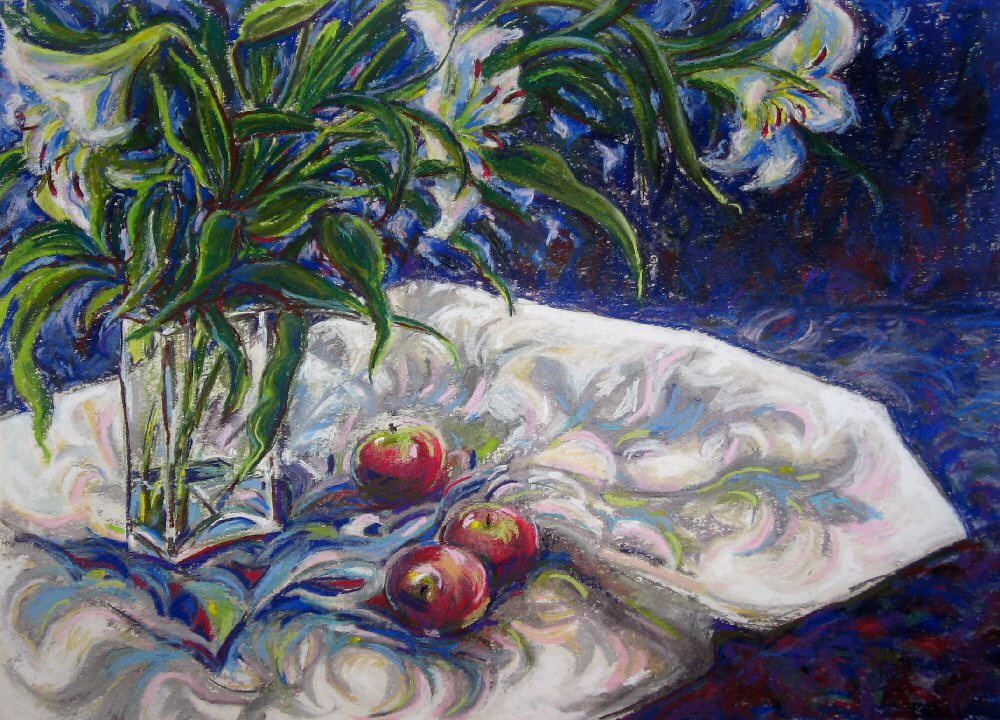
A Shadow of Lilies: Pastel by Jo: lit from directly above, Jo heightened the colours observed in the shadows
Secondly we should think about colour.
Two very different artists who exploited the use of complementary colours in cast shadows were Van Gogh and Wayne Thiebaud. The cast shadows in Van Gogh’s paintings of boots and also of bottles and earthenware pots of his home country were conventionally as brown and neutral as the objects casting them, but in his works just a few years later in the South of France, we see the sun and instead of dark shadows we see luminous complementary cool blues against yellow grounds. Thiebaud uses complementary colours in the cast shadows of his stylised rather Pop Art paintings of cakes, confectionary and even sardines. These cool almost turquoise blues make us feel the cool of shade as the temperature rises. They are not just observed they are also the shadows of the mind in a hot country just as neutral shadows are observed and their depressing drabness felt in less sunny climates.
Practical
This week’s challenge is to produce a still life composition that involves cast shadows so try placing a few objects where there is strong directional light either from a lamp or from a window. If you are relying on daylight the shadows will alter through the day so you may need to do one of three things; work rapidly (one hour maximum); return at the same hour and paint for a limited time each visit; or lastly take a photograph of your set up but do not use flash as you will not capture the cast shadows and you may introduce some unwanted ones.
Arrange and Observe
Don’t be too ambitious, perhaps choose two or three objects of different shapes and explore how they appear. Place them on a non-reflective cloth rather than a shiny surface to minimise confusion between shadows and reflections. You may of course notice how an exciting cast shadow has just been thrown up on a wall in your home from familiar objects. Then rush for your camera and sketch book, take a picture and draw from life if you have time. Look at the shape of the shadows and observe the colours in the shadow, especially if the shadow is from a transparent or translucent object. Also note whether the shadow has hard or soft edges. There may be more than one shadow. If so choose to depict the main shadow and the direction of light making that shadow.
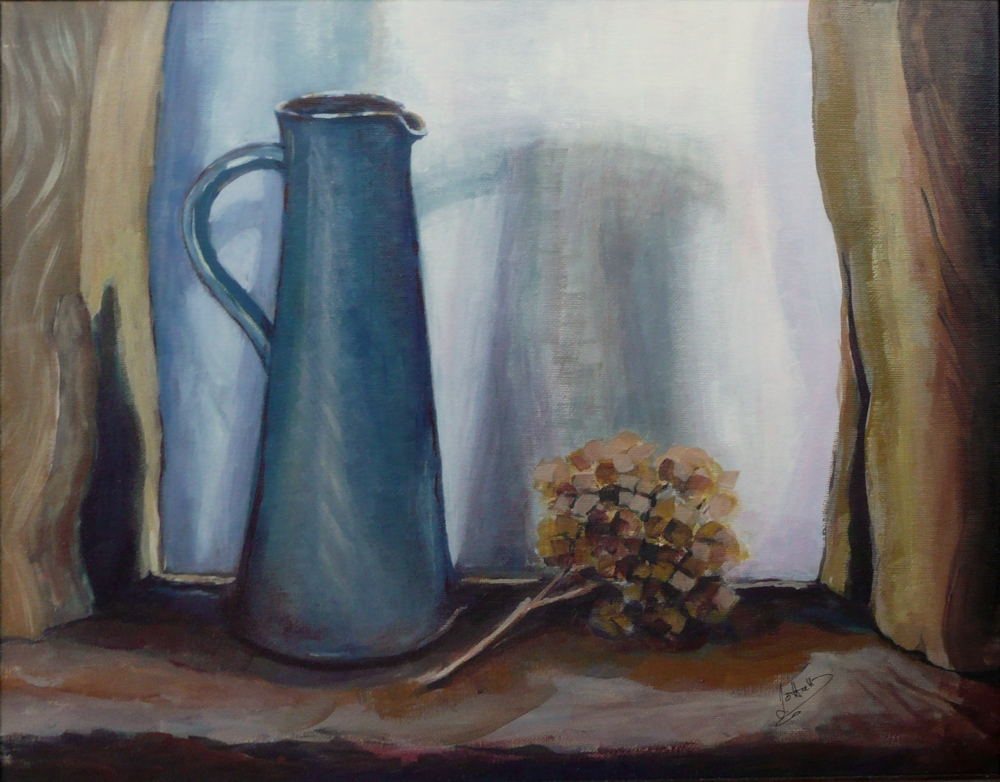
The Shadow of the Jug: oil on board by Jo; multiple shadows, soft edges, different colours in the shadow on the wall
Observe differences in tone between the object and the shadow especially where these meet and any differences in tone in different areas of the cast shadow.
If possible record what your arrangement looks like lit from the side and what it looks like when lit from above. Plants or flowers in vases can be fascinating subjects as the shadows can create a life form of their own, and can contain wonderful colours that can be exaggerated.
Another area to explore is to arrange an object so that it casts a shadow on to a curved surface or on to a folded cloth.
Draw and paint
It would be great if you could produce two drawings/rapid sketches of two arrangements with cast shadows and one finished painting in oil pastel or soft pastel, or water media (watercolour, gouache or acrylic). One object may be a plant form. Remember to look for the tone and colour of the shadows and whether there are both hard and soft edges.
More Ideas
Sometimes extraordinary things happen with shadows. I set up my narrow bottle with dandelion head on a surface in my workroom and the sun threw an amazing cast shadow which contained an internal reflection from the bottle so it appeared like an illuminated shadow. The roughly horizontal lines across the rest of the drawing are fiction but the shadow happened.
Once you are used to drawing and painting shadows as they are, it is great fun to play around with them; making a shadow in the right tone and direction but giving it a surreal twist by turning part of it into something different to the real shadow. You may even like to be disturbing by placing a shadow on the opposite side of the object to where it should be.
History and Reference Artists:
Copyright issues make it difficult for me to publish the works I would like to illustrate this post so it is illustrated with my work. I have put examples of works by the reference artists listed below on my Shadows Pinterest board.
https://www.pinterest.co.uk/pin/476044623087613785/
There are so many others but I hope this collection will give you some inspiration.
1659 Carel Fabritius:
The Goldfinch
1664 Francisco de Zurbaran: Still Life:
Note cast shadows on the cloth and of the handle of the vessel on the right and shadow cast by the upper right lip of that vessel
Van Gogh
1884/5: Still Life with Three Bottles and Earthenware Vessel
Note: tone and direction of shadows, composition, neutral colour
1889: Still Life: Drawing Board,Pipe Onions and Sealing Wax
Note: Tone of cast shadow not very different BUT use of complementary colour
Giorgio de Chirico
1919 Sacred Fish: in this surreal still life, like his paintings of surreal buildings and monuments the cast shadows form a hugely important element in the composition and is very different from his other still life style.
Salvador Dali
1924 Still Life: Sharp and soft edges
Giorgio Morandi
1919 Still Life: This metaphysical still life is completely different in style to the later style which he developed and kept to for several decades. Note its precision and hard edged cast shadows forming an intrinsic part of the composition. This is a still life of the mind not observation though the constructions are all built on the principles of what we know to be possible.
1943 Still Life: This still life is an example of the style we think of most; the skilfully arranged and observed arrangements of the objects Morandi collected and seemed to paint with love.
Wayne Thiebaud
During the 1950s and 60s, painted cakes and other food and shadows using complementary colours
Gerhard Richter
1965 Kitchen Chair: oil monochrome, hard and soft edges, realistic unlike Dali’s
Mary Fedden
Who died in 2012 produced many still life paintings, some where objects with and without cast shadows were included in the same work.
Contemporary artists;
Michael Naples
Avocado studies; may give you ideas for using simple objects
Chris Liberti
Some deceptively simple and some more complicated still life semi-abstract paintings; cast shadows, colour and composition
Eric Merrell
Thanksgiving: cast shadow from transparent vase
Jon Redmond
Plate with Apple
Alice Mumford
A rather impressionist handling of paint, one example of cast shadow and contre jour light
Elizabeth Geiger
Tea and port; crisp shadows make important contribution to composition
Your paintings;
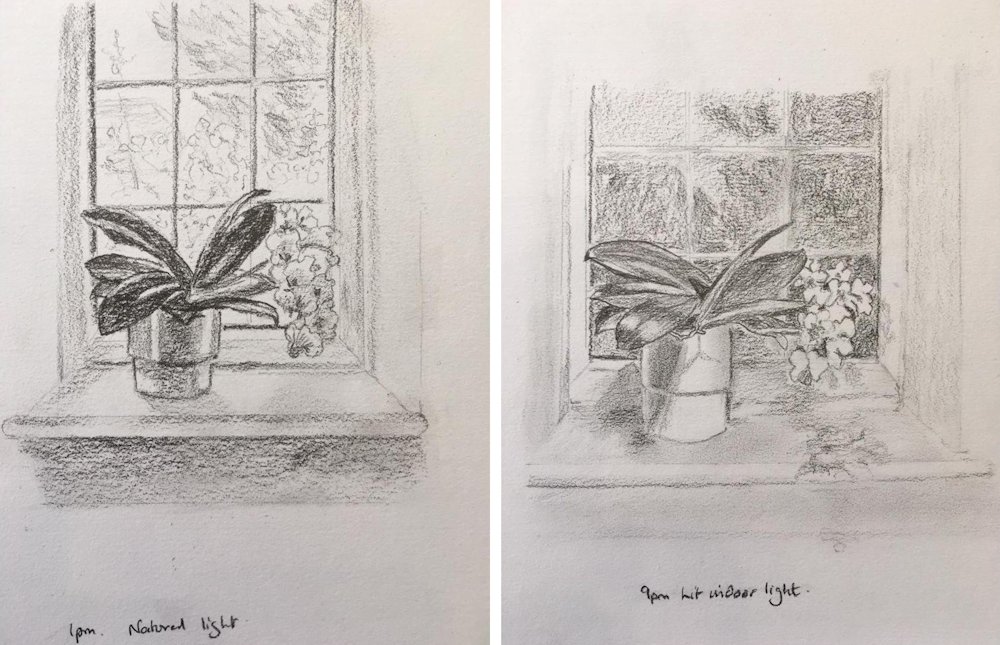
Drawings by Heather; daylight 1pm and indoor light 9pm note; compare differences in the cast shadows of the leaves on the plant pot, the darker leaves against the light outside during the day; the paleness of the flowers against the dark outside at 9pm; the cast shadows on the wndow sill and the darker tone under the window sill during the day; the contre jour leading of the window and window frame appear darker during the day than at night when the light is falling from within the room. All very well observed.
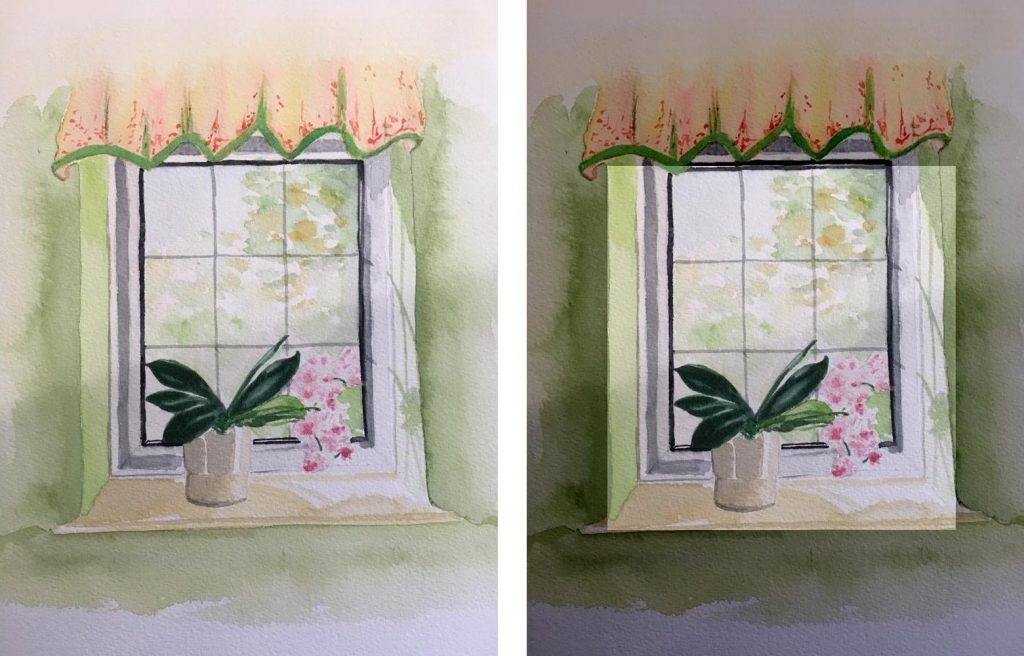
Colours in shadow areas become muted, taking a darker wash over the whole of the wall and curtain would have added drama and direct the eye to the window and plant. The shadows projected on to the window recess are beautifully painted.
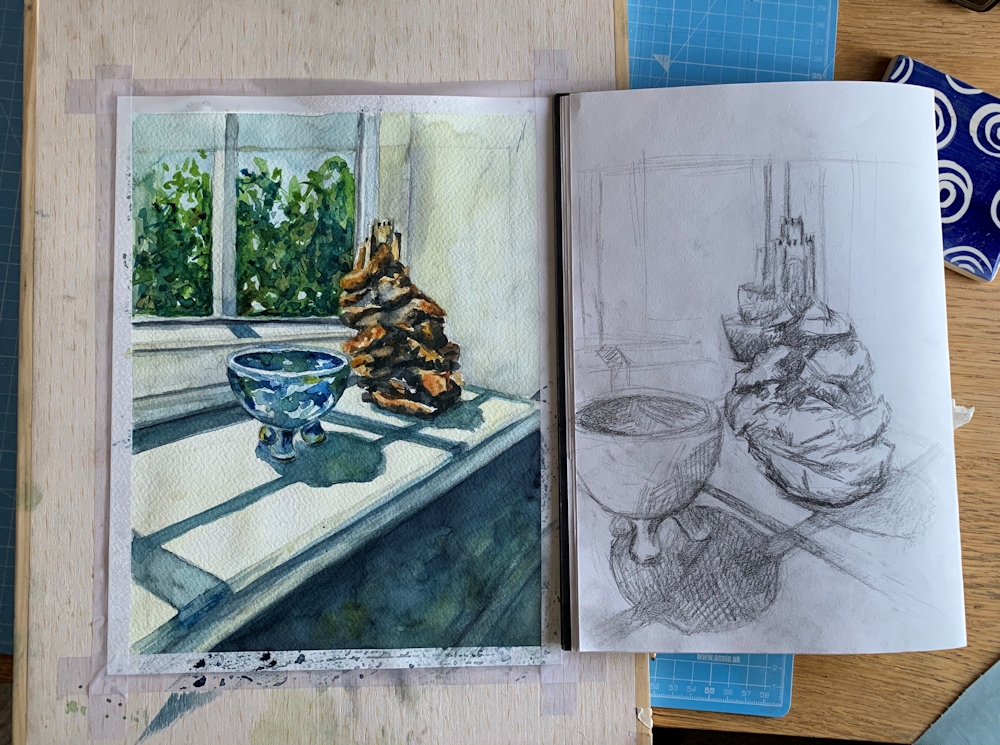
Watercolour and preliminary sketch from Jan; useful to work out ideas, viewpoint, composition and tonal values

Two pencil and pastel sketches by Liz; one with a rather diffuse morning light near a window and one of a vase in strong afternoon sunlight with a sharper cast shadow
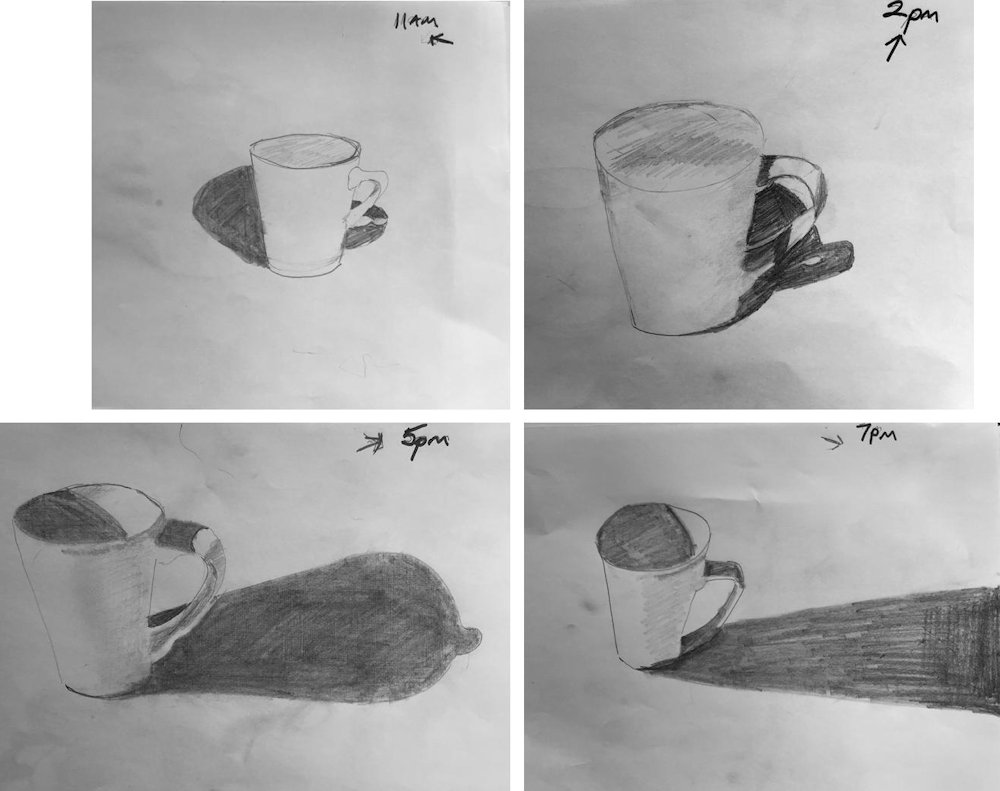
Drawings by Sandra: same mug different hours 11am 2pm 5pm 7pm; Sandra has observed the shadows cast on to the mug handle as well as on to the table, and the shadows within the mug
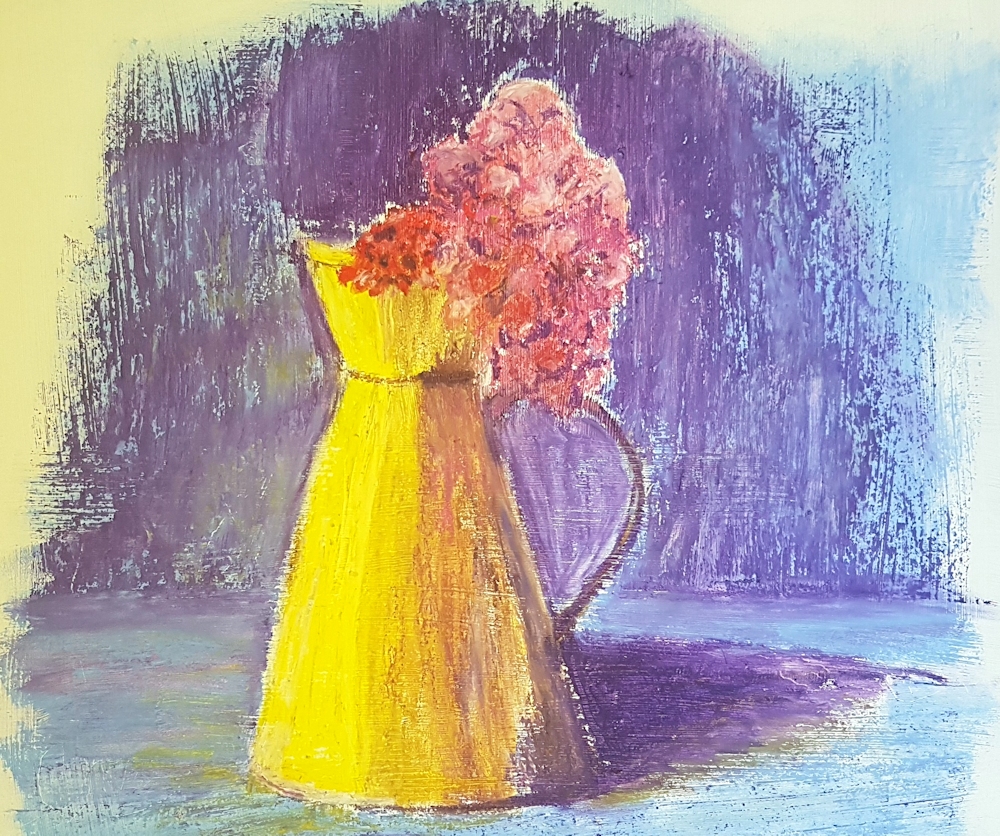
Yellow Jug: pastel by Ruth: Ruth has been inventive with the background and colour of the cast shadow, and the red/pink flowers make a colour bridge between the purple blue background colours and the and yellow jug.
